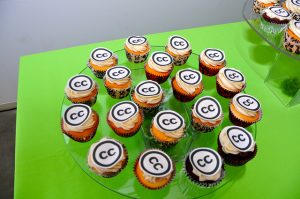17 Attributing Creative Commons Licenses
How to Write Open Attributions
Giving proper attribution to open works is easy if you remember a few simple rules and take the following steps:
Step 1: All CC licenses require attribution.
Not only do you want to give credit for work properly, but you want people to be able to find the original resource easily.
Step 2: Remember TASL.
- T = Title
- A = Author (tell reusers who to give credit to)
- S = Source (give reusers a link to the resource)
- L = License (link to the CC license deed)
When providing attribution, the goal is to mark the work with full TASL information. When you don’t have some of the TASL information about a work, do the best you can and include as much detail as possible.
Here is a picture that has been properly attributed with TASL:

“Creative Commons 10th Birthday Celebration San Francisco” by tvol is licensed under CC BY 2.0.
- Title (T): “Creative Commons 10th Birthday Celebration San Francisco.”
- Author (A): “tvol” – linked to his profile page
- Source (S): “Creative Commons 10th Birthday Celebration San Francisco” – linked to original Flickr page
- License (L): “CC BY 2.0” – linked to license deed
Step 3: Use a tool.
Open Attribution Builder: A web tool to assist users of CC material in attributing properly. It allows you to enter the title, URL for work, author and website, organization, and CC license type and provide attribution information that can be copied and pasted into your own work containing the CC material.
Step 4: Indicate a derivative or adaptation.
You should always attribute the original work to any derivative work and identify that changes have been made. Often the simplest way to do this is to use the phrase “Adapted from …” or “This work is a derivative of…” and attribute the original work as you would normally. If your work incorporates several derivative works, you might say, “Adapted from the following sources…” and list each original work sequentially. Keep in mind that materials with the Non-Derivatives license term (CC-BY-ND, CC-BY-NC-ND) are only allowed to be copied or redistributed as-is but NOT remixed.
Step 5: Where to place your attribution.
For text resources (e.g., books, worksheets, PowerPoint slides, etc.), include the attribution details where it naturally makes sense, such as immediately preceding or following the work, or as the footer along the bottom of the page on which the CC work appears. For videos, include the attribution information near the work as it appears on the screen during the video. For sound recordings (e.g., podcasts), mention the name of the artist during the recording (like a radio announcement) and provide full attribution details in text near the podcast where it is being stored (e.g., blog, school intranet, learning management system, etc.).
Remixing or Reusing Openly Licensed Works
Part of openly licensing works is that others can revise and remix them, creating derivative works based on the original. If you remix works, it is important to follow ethical attribution practices to ensure that creators are credited for their work while also ensuring that it is clear that the original creator does not endorse the derivative. Below is an example from the SPARC Open Education Leadership Program course materials.
Example of a proper attribution:
© 2018 SPARC. This work is licensed under a Creative Commons Attribution 4.0 International License. This work is an adaptation of the “OER Treasure Hunt Worksheet.” by Mathieu Plourde, also available under a Creative Commons Attribution 4.0 International License.
It is a good idea to keep intact the copyright notice provided by the original creator in the manner they specify, including specifying the author, title of the work, license, and URL.
Different media follow the same practices as marking works with a copyright statement to provide appropriate marking of republished or derivative works.
Note that for Creative Commons licenses, different versions of the licenses have different attribution requirements. Be sure to check Creative Commons’ handy attribution chart and attribution guidelines.
Licenses also get tricky when it comes to remixing resources. Some licenses have compatible terms, and others don’t. Check out this chart, and then take this quiz to test how well you understood the licenses. (Note that the quiz requires flash and may not work on all browsers). Remember that not all Creative Commons licenses permit revising and remixing, specifically the two licenses with the No Derivatives requirement.
References
CC Wiki. (2022). Recommended practices for attribution. Creative Commons Wiki. https://wiki.creativecommons.org/wiki/Recommended_practices_for_attribution Licensed under CC BY 4.0.
Community College Consortium for OER. (n.d.). Attributing OER. https://www.cccoer.org/attributing-oer/ Licensed under CC BY 4.0.
Creative Commons. (n.d.). 4.1 Choosing and applying a CC license. Creative Commons Certificate for Librarians. Licensed under CC BY 4.0.
Open Washington, SBCTC. (n.d.). Open attribution builder. https://www.openwa.org/open-attrib-builder/ Licensed under CC BY 4.0.
Paradiso, J. R., & Luken, D. (n.d.). Introduction to open education (Adapted from Parsons, J., OER specialist training manual). Licensed under CC BY SA 4.0.
SPARC. (2018). SPARC Open Education Leadership Program. https://sparcopen.org/leadership-program Licensed under CC BY 4.0.
tvol. (2012). Creative Commons 10th Birthday Celebration San Francisco. Flickr. https://www.flickr.com/photos/sixteenmilesofstring/8256206923/in/set-72157632200936657 Licensed under CC BY 2.0.

